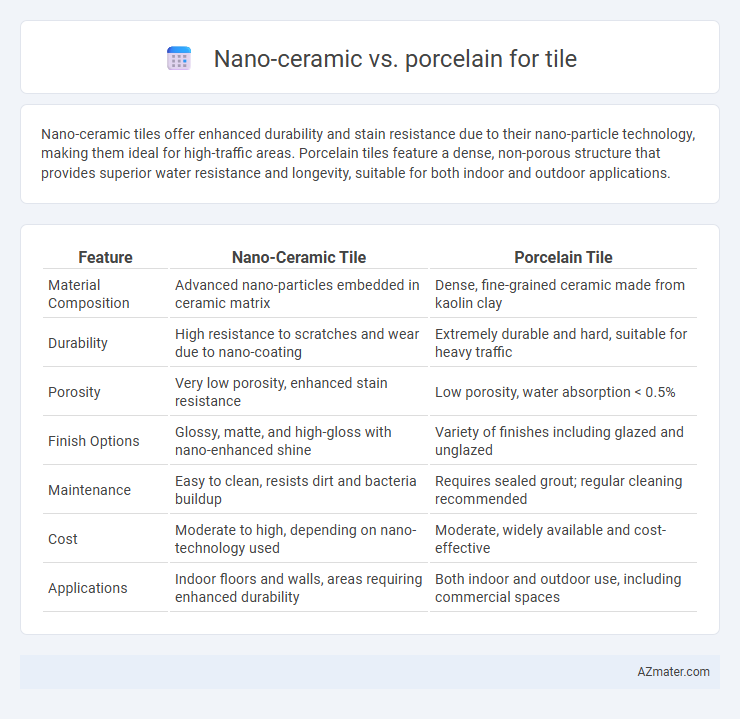Nano-ceramic tiles offer enhanced durability and stain resistance due to their nano-particle technology, making them ideal for high-traffic areas. Porcelain tiles feature a dense, non-porous structure that provides superior water resistance and longevity, suitable for both indoor and outdoor applications.
Table of Comparison
| Feature | Nano-Ceramic Tile | Porcelain Tile |
|---|---|---|
| Material Composition | Advanced nano-particles embedded in ceramic matrix | Dense, fine-grained ceramic made from kaolin clay |
| Durability | High resistance to scratches and wear due to nano-coating | Extremely durable and hard, suitable for heavy traffic |
| Porosity | Very low porosity, enhanced stain resistance | Low porosity, water absorption < 0.5% |
| Finish Options | Glossy, matte, and high-gloss with nano-enhanced shine | Variety of finishes including glazed and unglazed |
| Maintenance | Easy to clean, resists dirt and bacteria buildup | Requires sealed grout; regular cleaning recommended |
| Cost | Moderate to high, depending on nano-technology used | Moderate, widely available and cost-effective |
| Applications | Indoor floors and walls, areas requiring enhanced durability | Both indoor and outdoor use, including commercial spaces |
Introduction to Tile Materials: Nano-Ceramic vs Porcelain
Nano-ceramic tiles incorporate advanced nanotechnology to enhance durability, stain resistance, and surface smoothness, making them ideal for high-traffic areas. Porcelain tiles, known for their dense composition and low water absorption rates, offer exceptional hardness and longevity, suitable for both indoor and outdoor applications. Comparing nano-ceramic and porcelain involves considering factors such as wear resistance, maintenance requirements, and aesthetic versatility to determine the best fit for specific architectural needs.
Composition and Manufacturing Process
Nano-ceramic tiles are composed of fine ceramic particles combined with nanomaterials, enhancing strength and durability through advanced sintering techniques that ensure uniform density and reduced porosity. Porcelain tiles are made from a mix of fine-grained clays and feldspar, fired at higher temperatures to achieve a dense, vitrified structure that provides superior water resistance and hardness. The manufacturing process for nano-ceramic involves cutting-edge nanotechnology and precise temperature control, while porcelain relies on traditional high-temperature kiln firing for its robust, non-porous finish.
Surface Strength and Durability Comparison
Nano-ceramic tiles exhibit superior surface strength due to their advanced nanostructure, which enhances resistance to scratches and impacts compared to traditional porcelain tiles. Porcelain tiles provide excellent durability with a dense, vitrified composition, offering strong wear resistance and low porosity that prevents water absorption and staining. Both materials excel in longevity, but nano-ceramic tiles tend to outperform porcelain in maintaining surface integrity under high-traffic or abrasive conditions.
Water and Stain Resistance Levels
Nano-ceramic tiles exhibit superior water and stain resistance due to their dense, non-porous surface enhanced by nanotechnology, preventing moisture absorption and reducing staining risks. Porcelain tiles also offer high resistance to water and stains because of their extremely low porosity, but nano-ceramic tiles often provide a more advanced level of protection through enhanced surface treatments. Both materials are ideal for wet areas, yet nano-ceramic tiles typically outperform porcelain in maintaining aesthetic quality and durability against persistent exposure to water and staining agents.
Aesthetic Appeal and Design Variety
Nano-ceramic tiles offer a sleek, modern finish with high gloss and vibrant color retention, making them ideal for contemporary design aesthetics. Porcelain tiles provide extensive design variety, mimicking natural materials like stone, wood, and marble with intricate patterns and textures that enhance both traditional and modern interiors. The combination of durability and design flexibility makes porcelain a preferred choice for projects requiring diverse aesthetic appeal and style customization.
Cost Differences: Nano-Ceramic vs Porcelain
Nano-ceramic tiles generally cost less than porcelain tiles due to their lower manufacturing complexity and material composition. Porcelain tiles are denser and require higher firing temperatures, contributing to increased production costs and a higher retail price. Consumers often choose nano-ceramic for budget-friendly options while porcelain remains preferred for durability and premium aesthetics despite the higher investment.
Installation Process and Flexibility
Nano-ceramic tiles offer easier installation due to their lightweight composition and uniform size, allowing for precise cuts and quicker placement compared to porcelain tiles. Porcelain tiles, while heavier and denser, require specialized tools and more skill to install because of their hardness and brittleness. The flexibility of nano-ceramic tiles makes them ideal for curved surfaces and irregular spaces, whereas porcelain tiles excel in durability but are less adaptable to complex shapes during installation.
Maintenance and Cleaning Requirements
Nano-ceramic tiles offer superior stain resistance and require minimal maintenance due to their dense, non-porous surface that repels dirt and liquids effectively. Porcelain tiles, while also durable and low-maintenance, are slightly more porous and may need periodic sealing to prevent staining and moisture absorption. Both materials benefit from regular sweeping and damp mopping with mild cleaners, but nano-ceramic's advanced surface technology reduces the frequency and intensity of cleaning required.
Environmental Impact and Sustainability
Nano-ceramic tiles feature lower energy consumption during manufacturing due to advanced firing techniques, resulting in reduced carbon emissions compared to traditional porcelain tiles. Porcelain tiles, however, offer exceptional durability and a longer lifespan, minimizing waste and the need for frequent replacements. Both materials can be recycled, but nano-ceramic's innovative composition often includes eco-friendly binders, enhancing its sustainability profile in green building projects.
Best Applications: Where Each Tile Excels
Nano-ceramic tiles excel in high-traffic commercial spaces and outdoor settings due to their superior scratch resistance, low porosity, and UV stability, making them ideal for malls and patios. Porcelain tiles are best suited for residential flooring and bathrooms because of their moisture resistance, aesthetic versatility, and durability in moderate wear areas. Choosing between nano-ceramic and porcelain depends on factors like exposure to heavy use, environmental conditions, and design preferences.

Infographic: Nano-ceramic vs Porcelain for Tile
 azmater.com
azmater.com